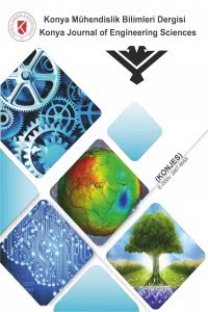Cu-%10Ni alaşımının erozyon-korozyon karakteristiklerinin ekonomik olarak değerlendirilmesi
Korozyondan kaynaklanan malzeme kaybının neden olduğu ekonomik maliyet endüstriyi etkileyen en önemli parametrelerden biridir. Bu çalışmada yapay deniz suyunda Cu-10%Ni alaşımının erozyon-korozyon davranışı incelenmiştir. Erozyon-korozyon testleri farklı hızlarda dönen silindirik elektrot kullanılarak gerçekleştirilmiştir. Bu alaşımın korozyon davranışı; açık devre potansiyeli, elektrokimyasal impedans analizi, ağırlık kaybı testleri ve optik mikroskop incelemesi ile belirlenmiştir. Dönme hızının artması ile yapay deniz suyundaki Cu-10%Ni alaşımının korozyon hızı artmıştır. Koruyucu yüzey filmi 1600 ve 2000 d/d dönme hızlarında hasara uğramıştır. Elektrokimyasal impedans verileri ve ağırlık kaybı verileri kullanılarak malzeme kaybı hesaplanmış ve dönme hızı 1200 d/d'dan daha büyük olduğunda malzeme kaybının arttığı bulunmuştur. Ekonomik açıdan yapılan değerlendirmede çalışma hızının kaybolan malzeme maliyeti üzerindeki etkisi belirlenmiş ve-çalışma hızının 1200 d/d'nm altındaki hızlarda olması gerektiği tespit edilmiştir.
Economical evaluation of Cu-10%Ni alloy erosion-corrosion characterization
Economical cost due to the material loss resulting from the corrosion is one of the most important parameters affecting industry. In this study, the erosion-corrosion behaviour of Cu-10%Ni alloy in artificial sea water has been investigated. The erosion-corrosion tests have been conducted using a cylindrical electrot rotating at different speeds. In the experiments, free corrosion potential tests, cycle polarization tests, electrochemical impedance spectrum (EIS) analysis, weight loss tests, and optic microscope observation were performed. The corrosion rate of Cu-10%Ni alloy in artificial sea water increased with increasing rotation speed and time. It was also determined that the breakdown of the protective film began at the rotation speed of 1600 d/d, and at the 2000 d/d. The material loss using electrochemical impedance and weight loss datas was calculated, and it was seen that material loss fairly increased after the rotation speed of 1200 rpm. The effect of rotation speed on the cost of lost rotation material was determined on the basis of economical evaluation, and it was found that rotation speed should be lower that 1200 rpm.
___
- Burleigh, T.D., Waldevk, D.H., 1999, Effect of Alloying on the Resistance of Cu-%10Ni Alloys to Seawater Impingement, Corrosion, Vol.55, 8.
- Doruk, M., 1982, Korozyon ve Önlenmesi, ODTÜ Müh. Fak. Yay. No: 70, 247 (107).
- Gavgalı, M., Totik, Y. and Nevile, A., 2002, Yapay Deniz Suyunda Farklı Hızlarda Cu-%10Ni Alaşımının Erozyon-Korozyon Davranışı, Mühendislik Bilimleri Dergisine yayınlanmak üzere kabul edildi.
- Gilbert, P.T., 1982, A Review of Recent Work on Corrosion Behovior of Copper Alloys in Seawater, Materials Performance Vol. 21, 247.
- Hack, H. and Pickering, H., 1993, The Influence of Corrosion Product Film Formation on The Corrosion of Nickel Alloys in Aqueous NaCl, Elektrochemical Impedance: Analysis and Interpretion, ASTM STP 1188, J.R. Scully, D.C. Silverman, and M. W. Kendig, Eds., American Society for Testing and Materials, Philadelphia, 220-236.
- Henrikson, S., Knutson, L., British Corrosion, J., 1975, Corrosion Tests in Baltic Sea Water on Heat Exchanger Tubes of Various Metallic Materials, Vol. 10, 128.
- Kato, C, Castle, J.E., Ateya, B.G. and Pickering, H.W., 1980, On the Mechanism of Corrosion of Cu-9,4Ni-l,7Fe Alloy in Saturated Aqueous NaCl Solution, II. Composition of the Protective Surface Layer, Journal of the Electrochemical Society, Vol.127, 1897.
- Laachach, A., Srhiri, A. and Benbachir, A., 2000, Corrosion behaviour of cupro-nickel 70-30 in 3%NaCl medium influence of addition of sulphide ions, Bultein of Electrochemistry, No.5, Vol.16, 193.
- Mathiyarasu, J., Palaniswamy, N. and Muralidharan, V.S., 2000, Corrosion Resistance of cupronickels-An Overview, Corrosion Science and Engineering Division, Central Electrochemical Research Institute, Karaikudi - 630 006, India, pp.76.
- Nesic, S. and Solvi, G. T., 1995, Enerhoug, Comparision of the Rotating Cylinder and Pipe Flow Tests for Flow-Sensitive Carbon Dioxide Corrosion, J. Corrosion, Vol.51, 773.
- Popplewell, J.M., Hart, RJ. and Ford, J.A., 1973, Effect of Iron on the on Corrosion Characteristics oif 90-10 Cupronickel in Quiiescent 3,4 NaCl Solution, Corrosion Science, Vol.13, 295.
- Üneri, S., 1998, Korozyon ve önlenmesi, Korozyon Derneği Yayını, Ankara, 413 (4).
- Tait; W.S., Handric, K.A., Tait, S.W. ve Martin, J.W., 1993, ASTM STP 118, pp.428-437
- Wood, R. J. K., Hutton, S.P. and Schiffrin, D.J., 1990, Mass Transfer Effects of Non-Cavitating Seawater on the Corrosion of Cu and 70Cu-30Ni, Corrosion Science, Vol.30,1171.
- Zheng, Y.G., Yang, F., Yao, Z. and Ke, W., 1990, Erosion-Corrosion of Cu-Ni Alloy Bfe30-l-l in Artifical Sea Water, Z. Metallkd Vol.91, 323.
- ISSN: 1300-5200
- Yayın Aralığı: Yılda 4 Sayı
- Başlangıç: 2018
- Yayıncı: -
Sayıdaki Diğer Makaleler
Hacim hesapları için GPS ölçülerinin klasik ölçmeler yerine kullanılabilirliği
CEVAT İNAL, ÖZŞEN ÇORUMLUOĞLU, İsmail ŞANLIOĞLU, CİHAN ALTUNTAŞ
Uzun bazlı GPS ağlarında faz bilinmeyeni (Ambiguity) çözüm yöntemleri
ÖZŞEN ÇORUMLUOĞLU, İBRAHİM KALAYCI
İçerikışla formasyonuna (Seydişehir, Konya) ait dolamitlerin jeolojik ve petrografik özellikleri
Hükmü ORHAN, M. Muzaffer KARADAĞ
Cu-%10Ni alaşımının erozyon-korozyon karakteristiklerinin ekonomik olarak değerlendirilmesi
Bulanık küme teorisi ve doğrusal programlamada kullanımı: Karşılaştırmalı bir analiz
EGM96 jeopotansiyel modeli ve GPS/nivelman ile elde edilen jeoit ondülasyonlarının karşılaştırılması
